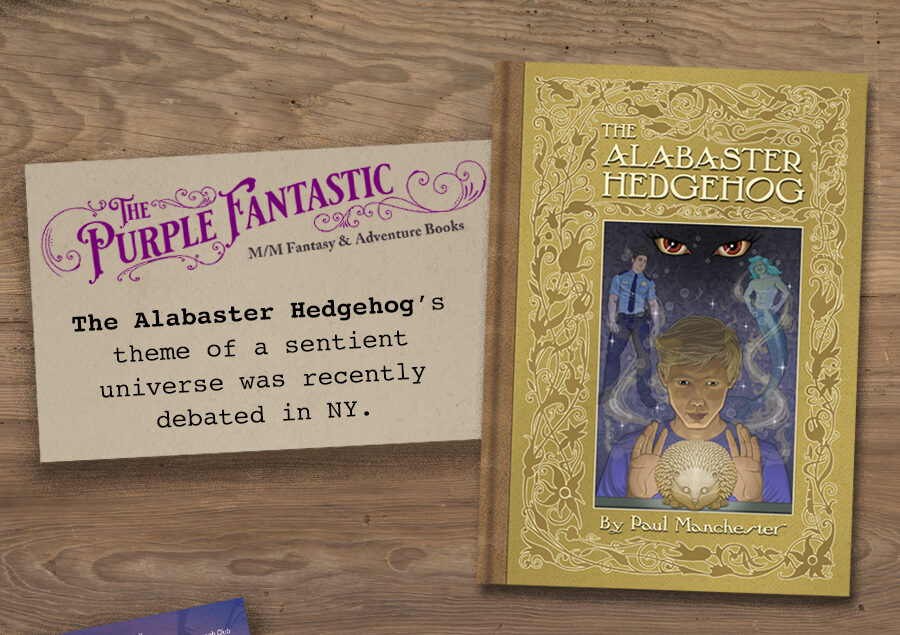The Alabaster Hedgehog and Panpyschism
I was thrilled to run across an article this morning in Scientific American about a conference in New York where attendees debated the concept of Panpsychism. Since childhood, this has always been how I have intrinsically viewed the world. It just seems to make sense to me. So naturally it is an underlying premise of my book The Alabaster Hedgehog, (and to a lesser extent it is also an underpinning of Olly Olly Oxen Frey).
What is panpsychism?
“Part of the appeal of panpsychism is that it appears to provide a workaround to the question posed by Chalmers: we no longer have to worry about how inanimate matter forms minds because mindedness was there all along, residing in the fabric of the universe. Chalmers himself has embraced a form of panpsychism and even suggested that individual particles might be somehow aware. He said in a TED Talk that a photon “might have some element of raw, subjective feeling, some primitive precursor to consciousness.” Also on board with the idea is neuroscientist Christof Koch, who noted in his 2012 book Consciousness that if one accepts consciousness as a real phenomenon that’s not dependent on any particular material—that it’s “substrate-independent,” as philosophers put it—then “it is a simple step to conclude that the entire cosmos is suffused with sentience.”
https://www.scientificamerican.com/article/is-consciousness-part-of-the-fabric-of-the-universe/
“If all of this sounds like it couldn’t possibly have any practical value, Goff raised the possibility that how we conceive of minds can have ethical implications. Take the question of whether fish feel pain. Traditional science can only study a fish’s outward behavior, not its mental state. To Goff, focusing on the fish’s behavior is not only wrong-headed but “horrific” because it leaves out what’s actually most important—what the fish actually feels. “We’re going to stop asking if fish are conscious and just look at their behavior? Who gives a shit about the behavior? I want to know if it has an inner life; that’s all that matters!” For physicalists such as Carroll, however, feelings and behavior are intimately linked—which means we can avoid causing an animal to suffer by not putting it in a situation where it appears to be suffering based on its behavior. “If there were no connection between them [behavior and feelings], we would indeed be in trouble,” says Carroll, “but that’s not our world.””
I don’t think that it has to be the either-or discussion that these debates fall into. The idea of consciousness residing at the core of everything does not negate the exciting search for a better understanding of the universe’s mechanics.
But why doubt that the fish or the ant has an experience of its own as it explores its world? Doubting innate consciousness is a tool to provide comfort – not unlike slaveholders rationalized their heartless behavior by convincing themselves that slaves had no real feelings. But it is small minded fear of changing behaviors that benefit self and deny empathy. It makes the world more complicated. It forces us to examine out ethos. Innate consciousness is an uncomfortable idea as I like a salmon dinner, and I do not like ants in my kitchen – but just because it is an uncomfortable idea, does not mean that I can pretend that fish and ants are unfeeling automatons. Their experience is different than mine, but it is still their experience. Right and wrong begin to get messy.
A belief in a core consciousness in everything around us makes innate sense to me. Trees and plants also have an awareness – different than ours – yet they do experience their world in their own way. (I strongly recommend The Hidden Life of Trees – it is fascinating! It is not mystical silliness… it is fact based research from a forrester).
Does a rock or a spoon have awareness? How do we even define awareness for something whose essential experience is so fundamentally different from ourselves? I’ve no answers here, these are simply interesting questions. What if’s. And What if’s are the diving boards to the swimming pools of story.
Anyhoo… in The Alabaster Hedgehog, our hero Thaddeus and his great uncle Lester love to repair objects, and the idea of listening to the object being repaired was a fun concept to explore.
Note: The edition of The Alabaster Hedgehog featured above, is the hardbound edition which should be available by late October. The hardbound editions of The Alabaster Hedgehog and Olly Olly Oxen Frey (full color) will be beautiful. Spot varnish on the covers and a few extra features in the content… I am ridiculously excited about them.

